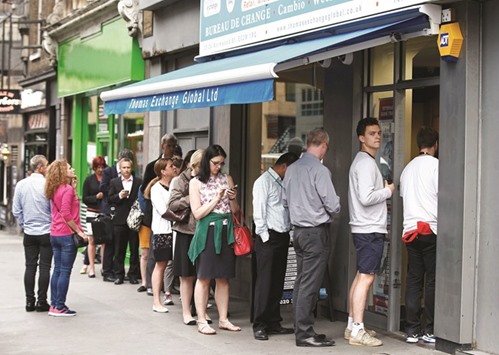Bond and currency traders seeking refuge as the UK voted on membership in the European Union may have found that the world’s financial-market havens aren’t so safe.
There were already signs that liquidity, the ability to trade without affecting prices, had been deteriorating in some investment oases in advance of the ballot. The yen strengthened as much as 0.6% in the space of a minute yesterday before giving up much of the gains almost immediately.
Liquidity has dropped by about a third in European sovereign bonds, according to David Page, a senior economist in London at AXA Investment Managers. Vanguard Group, which manages about $3.5tn, is hearing from currency dealers that they may provide indicative, rather than firm, prices in the event volatility climbs. In the pound, which is at the centre of global scrutiny, some investors are reluctant to hold spot positions, according to Europe-based traders.
“Everybody’s just preparing for the potential of a shortage of liquidity,” said Andy Maack, head of foreign-exchange trading at Vanguard in Malvern, Pennsylvania. “For the first time I can remember, we’ve actually gotten notices from all our counterparties saying that they might not be able to provide pricing, that their prices might turn into indicative pricing during a period of time, that they might suspend algorithmic trading.”
Australia & New Zealand Banking Group joined lenders including UBS Group AG and Societe Generale in cautioning clients that its ability to provide the usual levels of currency liquidity as well as pricing could be constrained, according to a memo seen by Bloomberg. Chicago Mercantile Exchange said in a note it has increased special price fluctuation limits for all currency futures and options from June 22 to June 24 to ensure fair and orderly trading.
CME modified limits “based on the strong likelihood of increased price volatility expected to result from the ‘Brexit’ vote,” it said on its website.
As investors navigated a potential Brexit, worsening liquidity raised the difficulty of unloading or adding positions. It also heightened the risk that there will be repeats of the bouts of turbulence that’ve rocked global markets in the past year.
Consider that New Zealand’s currency suffered its biggest intraday drop in 30 years in August, the same week that dozens of US exchange-traded funds diverged from the value of their underlying shares.
In January, the South African rand tumbled 9% in 15 minutes before rebounding, and last week, a measure of volatility in Group-of-Seven currencies rose to a four-and-a-half-year high.
Polling indicates a close race. Bank of England officials had warned about the risk of a “Leave” victory for the UK economy, while the Federal Reserve left interest rates unchanged last week and cited a potential British exit as a factor in its decision.
The yen, a refuge in times of turmoil, appreciated to 103.55 per dollar last week, its strongest in almost two years, and traders are braced for more strength. The premium for one-month options to buy the yen versus the greenback, over the cost of contracts to sell, climbed to the most since 2010, data compiled by Bloomberg show.
Yields have tumbled in the US, the world’s biggest bond market, which had its own episode of unusual turbulence in 2014. On October 15 that year, in a span of 12 minutes, benchmark 10-year yields slid 0.16 percentage point then rebounded, prompting the first government review of the market since 1998.
Last week, benchmark 10-year Treasury yields touched 1.52%, the lowest since 2012.
Investors can prepare for volatility by running stress tests on portfolios and adjusting positions incrementally as information emerges after the referendum, said Sinead Colton, San Francisco-based head of investment strategy at Mellon Capital.
The challenge for investors battening down the hatches is that everyone wants to buy the same assets, said James Kwok, London-based head of currency management at Amundi, which oversees about €987bn ($1.1tn).
“It’s easy to identify — the Japanese yen is a safe haven, US Treasuries are a safe haven,” Kwok said. “The problem is when you have big size, you need to buy enough to hedge your whole portfolio — and at this point, you run into the liquidity problem.”

People queue for foreign exchange at a currency bureau in London yesterday. As investors navigated a potential Brexit vote yesterday, there were already signs that liquidity, the ability to trade without affecting prices, had been deteriorating in some investment oases.


